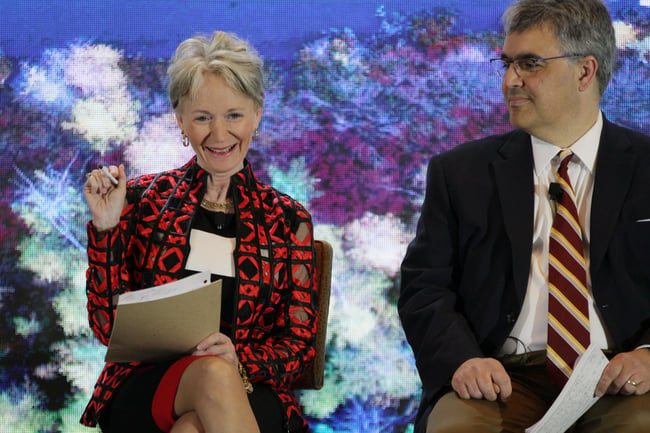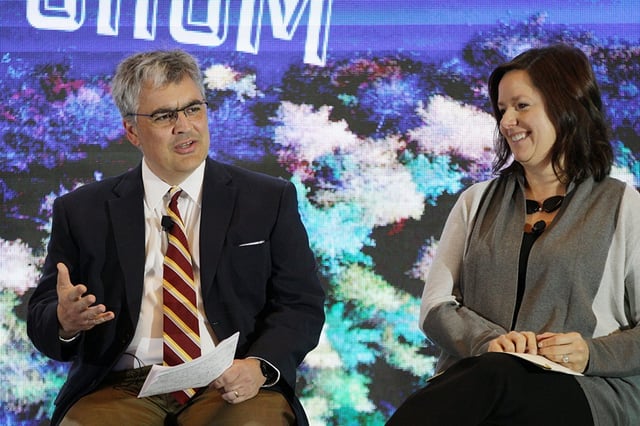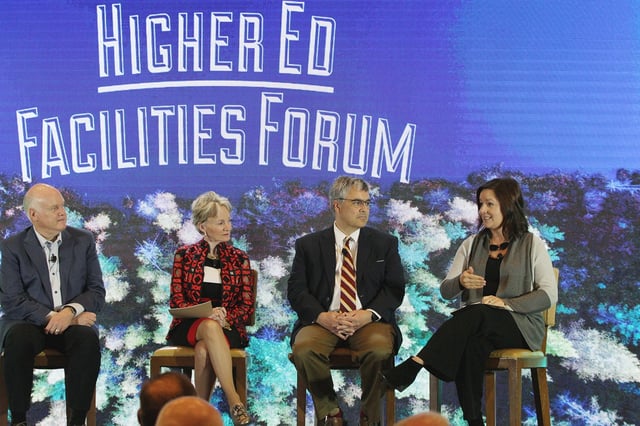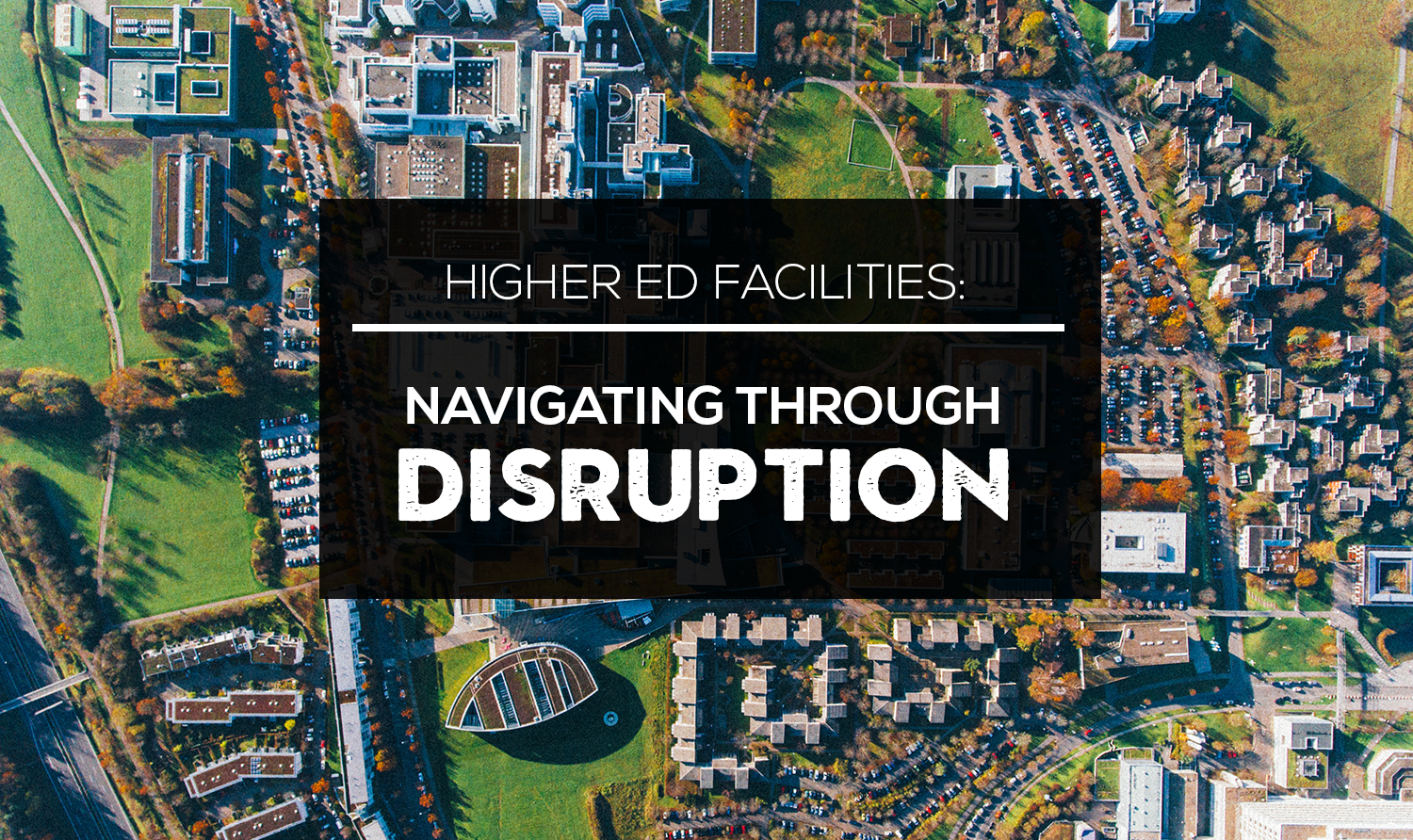In 1997, the famous management guru Peter Drucker made a provocative statement: “Today's [university] buildings are hopelessly unsuited and totally unneeded. Thirty years from now, big university campuses will be relics.”
Well, the year is 2018: nine years off from Drucker’s prediction, and universities are still standing yet certainly not unscathed. Just last year, Gallup found that 71% of university chief financial officers believe that higher education is in the midst of a financial crisis. In addition, 57% of board members surveyed said that public perception of higher ed has declined.
At the Higher Ed Facilities Forum, facilities leaders from North America’s top universities explored innovative approaches to some of the industry’s greatest challenges. During an interactive session facilitated by Pete Strazdas, Associate Vice President of Facilities Management for Western Michigan University, we heard from an audience of 100 facilities leaders from colleges and universities of all sizes. Discussion leaders included:
- Mike Berthelsen- Vice President, University Services, University of Minnesota
- Heather Tonk Christophersen- Director of Maintenance, University of Notre Dame
- Lee Kernek- Associate Vice President for Administration and Finance, University of Central Florida
- Tom Morrison- Vice President, Capital Planning & Facilities, Indiana University
“Frankly, with all the negativity out there, we need to be talking about disruption and transformation,” said Strazdas. “As Winston Churchill so wisely said, ‘Never let a good crisis go to waste.’”
From innovative solutions to deferred maintenance to space management and funding, it’s clear that facilities leaders are taking Churchill’s advice to heart.
 Pete Strazdas, Western Michigan University and Tom Morrison, Indiana University.
Pete Strazdas, Western Michigan University and Tom Morrison, Indiana University.
Space Management
Strazdas kicked off the discussion by asking each panelist about their current greatest challenge. Tom Morrison, VP of Capital Planning & Facilities at the University of Indiana, was first to answer.
“It’s a struggle to right-size our campus in terms of space management, looking at the future for the new ways students learn and people work,” he shared.
Thanks to technology, today’s professors don’t always need to be physically on campus; and the result is an abundance of unoccupied offices across campuses.
“We get asked all the time about the impact of online education on what we do, but it’s been around for a few decades. People predicted it would be the end of the college campus. That hasn't been true, but it's certainly a hybrid model now. We have to be able to capture that in terms of scheduling and maximize that space,” Morrison said.
Strazdas agreed, citing that industry standards are at about 30-40% utilization--an inefficient, abysmal statistic for trillions of dollars of assets. He turned to the audience for input.
Dave Irvin, AVC for Facilities Services at the University of Tennessee, commented that UT’s space is all centralized.
“Conference rooms, classrooms, and labs are scheduled centrally, which doesn't sound like a huge deal but was a big change for staff. We now have a lot of central open offices instead of individual ones. We haven't cracked that on the academic side with faculty, but are slowly heading in that direction.”
Howard Wertheimer, Institute Architect at Georgia Tech, believes that other industries would be out of business with such high vacancy rates. “We need to change the fact that it’s acceptable in higher ed.”
 Tom Morrison, Lee Kernek, Mike Berthelsen, and Heather Tonk Christophersen.
Tom Morrison, Lee Kernek, Mike Berthelsen, and Heather Tonk Christophersen.
Despite receiving some initial pushback, Georgia Tech is utilizing a new metric to help better manage space in an interdisciplinary research building currently under construction.
“The metric is 80/20-- 80% is open offices and 20% is enclosed offices. The largest office is 120 square feet. We also set up metrics of small, medium, and large breakout rooms so there's always a place to meet, rather than an office,” Wertheimer shared.
“I would say if there's no resistance, we’re not doing our job,” Strazdas commented. “In an industry that's unsustainable, if the faculty isn't disrupting, it’s up to us to transform.”
Funding
The financial challenges facing higher ed are no secret. With institutions being forced to reassess their way of doing business, facilities organizations are far from immune from the pressure to operate leaner.
Lee Kernek, Associate Vice President for Administration and Finance at the University of Central Florida, shared that funding is her greatest challenge. In Florida, UCF is dealing with an 11% increase in construction costs.
“In public higher education, the state used to cover 80% and tuition covered 20%--now, that has almost flipped,” she said. “We’re really hurting with costs continuing to rise. The trades aren't there, the price of steel and concrete is higher, and our donors don’t give the way they used to before the academic downturn.”
Strazdas agreed, stating that: “We’re headed toward the perfect storm with enrollment and money. When you look at declining demographics, there's a lot of stress.”
Wertheimer believes that there’s an opportunity for cost savings with more efficient space utilization. “Again, you have these assets that could be vacant 65% of the time, if you’re lucky. We worked with our registrars and provost office to extend formal teaching and learning hours from 8 am to 8:45 pm, which helps us in facilities not have to deal with new assets.”
Alicia Knight, SVP for Operations at George Washington University, shared that institution-wide budget cuts over the past five years actually created an incentive for facilities to dig deep on how they were utilizing not just real estate assets but also human capital. GW found that they were spending exorbitant amounts on overtime for staff when outsourcing was a more cost-effective solution.
“I would venture to say that after cutting 10% of our budget, we’re actually doing things better now than before. We took advantage of this crisis as an opportunity,” she said.
Andy O’Brien, Chief of Operations at Harvard Business School, said his institution looking at non-traditional ways of obtaining funding.
“Online education is something new to many of us and has the potential to be a revenue source.” he said. “Adult education and continuing education for different types of learners use fewer resources, like residence halls. We've been lucky enough to start our own publishing company to add to our revenue stream.”

John Moore, AVP for Facilities Management Services at Rochester Institute of Technology, is trying to increase the transparency of what facilities management does and how much it truly costs to operate space per square foot.
“I’ve got 25 new faculty members showing up in the fall, and zero offices to support them, so how do we manage that? I’m putting the transparency out there--if we add space, the bottom line is affected, so we’re looking at other answers and possibilities.”
Strazdas agreed that widening the bridge between academics and facilities is a necessity. “We’ve been in our silos, but we've got to figure out how to work together. It used to be the public's money--now it's the parents’ money. They want to know where it's going; they demand accountability and transparency.
Shane Conklin, AVC of Facilities & Campus Services at UMass Amherst, mentioned the success of a strategic MoU with their regional energy provider. The aggressive goal of the current three-year MoU is to save $1.8 million in annual energy costs. As part of the agreement the energy provider helps secure incentives to offset costs of energy efficiency work.
“Although we have a central heating plant, we purchase about one third of our electricity from the grid, and have partnered with them for incentives as we renovate and build new to drive energy efficiency efforts. Our campus also has an E+ program; when a project has approximately seven years of payback, the campus will fund the project and get repaid from the corresponding utility budget reduction.”
Niraj Dangoria, Associate Dean of Facilities Planning & Management at Stanford Medical School, commented that there really hasn’t been a new source of funding in higher ed for the last several years. However, he pointed out that facilities leaders control one of the largest assets on our campuses.
“There is a huge opportunity. As facilities leaders, we must leverage our underutilized spaces for funding with creativity, especially in urban places where is a high demand,” Dangoria said. “We sit on one of the most valuable financial pieces--the real estate-- so let’s use it and make a contribution to the university.”
Data-Driven Integration
For Mike Berthelsen, VP of University Services at the University of Minnesota, the beginning challenge lies in creating a data-driven, integrated process. Although there is much pressure for facilities leaders to do more with less (and faster), many are still dealing with information and work-order systems that are extremely outdated.

“Physical assets are the second-largest cost, yet it’s only a recent development for us in facilities to connect all the information we need to make informed decisions. We have enterprise-wide systems for finance and HR and students and staff, and then facilities have systems that go back to early PCs,” Berthelsen said.
The University of Minnesota is currently in the process of selecting the software to create a more integrated process--one that incorporates real estate, space, maintenance, and construction across the board for all its campuses across the state.
It’s not just about the software, however: people, process, and information are an essential part of the transformation.
“You can buy new software, but it will work just as poorly as your previous system unless you put in the time to right-size, streamline, and interconnect the processes from idea all the way through construction, operation, and utilization,” Berthelsen said.
“This creates the ability to not just have more data but integrate that data in a uniform process, make better decisions, and get the right information to respond to stakeholders and customers. ”
John D’Angelo, VP of Facilities at Northwestern, shared that his team is currently on the same path, but taking integration one step further.
“Integrating within facilities is a no-brainer, but what about connecting with the HR database and the financial database? Then you can push out these benchmarks to all end users, to all the deans and their staffs, so they can do calculations including cost per square foot, and manage their own portfolios. This is much more powerful than facilities just sitting on this data. It needs to be accessible to all and have a user interface that everyone is comfortable with.
They're able to inform themselves and come back with sharper requirements for us to execute, which puts us in a much better place.”
“What if we were perceived as a profit center, rather than a cost center, in facilities?” Strazdas commented.
Dangoria chimed in, agreeing that data for the sake of data doesn’t do anything.
“One of the things we’ve found is that data is seen as very personal, so how do you convey the essence of the message without bludgeoning someone with data?” Dangoria said. “At Stanford, we’ve set up a system where we measure space with three different metrics on how each department is doing. Then we distribute that to all our department chairs and present it to our cabinet.”

They then focus on working with the lowest 25% to enhance their space utilization. He also noted that another challenge is that facilities is often the lowest priority for IT help; so, “to leverage the data that is being generated all over the place, we have to acquire more intelligence by starting our own small IT departments in facilities.”
Deferred Maintenance
Deferred maintenance may not be as sexy as data and technology, but it can’t be ignored when discussing facilities greatest challenges.
Heather Tonk-Christopherson, Director of Maintenance at the University of Notre Dame, realized that deferred maintenance was becoming a real problem about eight years ago when an external vendor came in to do a buildings and conditions report.
“We've built an additional one million gross square feet. When you look at our future needs, the funding isn't going to be there. When we went to the board and told them we had a problem, part of the response was, ‘But everything looks so nice.’ It’s a definite struggle for many people outside of facilities to understand all the nuances underneath the buildings,” Tonk-Christopherson said.
The problem was that her department didn’t have the data to show the future consequences. They hired a company to come in and prioritize their needs and budget and were able to get more funding once they had the data to deliver to the board. However, they didn't keep track of the assets and priorities well enough to keep up with the information, so Notre Dame had them come back about a year ago to assist with their work management tool.

“We are at the beginning of this process to stay on top of this data and continually get this information to decision-makers,” Tonk-Christopherson said.
Irvin agreed with Tonk-Christopherson on the challenge of articulating deferred maintenance to the board.
“We’ve all done these audits, everyone has this long list, we’ve heard that we have a billion in deferred maintenance which makes everyone’s eyes roll over and gets no traction. How do we get it down to a size we can begin to address?”
He believes part of the answer lies in looking at the issue from a different perspective.
“We’ve traditionally viewed it from a facilities standpoint, like which building system is the oldest or which HVAC system needs to be replaced. And we've made decisions that way, but that's only part of the equation,” he said.
Facilities must broaden their scope to look at how it affects risk management, business continuity, and the university’s mission as a whole. Irvin believes that deferred maintenance decisions and strategies shouldn’t just be made by facilities and the CFO; the academic and research side must get involved too.
“We look at not just how old the building is, but how critical that building is to the academic mission of the university as well as how critical the facilities systems are. There may be some buildings with terrible systems, but they’re not critical to the mission because you can put those things elsewhere or do them off campus; to be blunt, they don’t bring in the dollars.
When you look at deferred maintenance that way, you can begin getting that billion dollar number down to a more manageable size to maximize those really rare resources and support what your university is trying to do on the academic and research side.”
O’Brien also emphasized the need to look at deferred maintenance from a scope outside facilities--and putting “facilities speak” in terms of what decision-makers can relate to.
“Knowing that we work with accountants and finance professionals, we can look at it in terms of depreciation--that’s a number they understand,” he shared. “Asking ‘Will you fund depreciation on each building?’ is more effective than simply asking for a billion dollars. If they won’t fund depreciation, then you can ask what level of that number might be funded and determine the priorities.”
Berthelsen chimed in that the University of Minnesota has also eliminated the term “deferred maintenance.” Instead, they say “deferred capital renewal” or “deferred investment.” He believes that it’s up to facilities to change the dialogue, considering the fact we are shooting ourselves in the foot industry-wide on this topic.
“It simply doesn’t work with decision makers, and it tends to make legislators think were incompetent and not doing our maintenance job,” he said. “They’ll say, ‘Why didn’t you do the maintenance?’ But we are... we just don’t have the money for renewal. You can change a tire or change oil, but at some point, the thing is gonna die! Give analogies or comparisons to simplify it-- people understand they need to replace tires.”

Strazdas expressed approval for “a different spin on an old problem that people are so tired of hearing about.” He then asked the audience about the capital construction underway right now. “What are you doing, in 2018, to do it right the first time so there isn’t this negative legacy of deferred maintenance 10, 20, or 40 years from now?”
D’Angelo answered that because math is “harder to argue with,” he uses the recapitalization rate.
“Our plant replacement value is $8 billion, and if we get $160 million a year, the dollars cross out. That allows me to show how many years the plant has left to go, and I find that to a be much easier conversation with our president and CFO. I couldn’t spend a billion dollars in a year if they gave it to me anyway; what I want is a predictable, manageable flow,” he said.
After coming off a 3-year, $2.2 billion dollar build, Northwestern created a process to make sure “the tail got built in at the front end,” so to speak. The operating costs (including the recapitalization costs) were built into the decision-making, meaning that D’Angelo doesn’t have to fight for those dollars in the new portfolio because it’s already pre-approved.”
Gerardo Rodriguez, Director of Capital Projects at University of Texas Rio Grande Valley, also mentioned the value of a five-year CPI list, which is a live document that they updated a couple of times a year.
“This includes all capital projects and any deferred maintenance, and other projects we know need to be done. It helps our CFO get a big picture view of what the total dollars are at the bottom of that column every year. Obviously, we can't fund even 50% of it, but we keep updating and are able to prioritize every year based on actual needs, so it helps us chip away at that list.”
The Future of Higher Ed Facilities
Wrapping up the lively discussion, Strazdas encouraged a rapid-fire finale to the question: “What is your greatest challenge?” Answers included:
- Changes in work/business
- Doing more with less: limited time/resources, declining funding
- Aging workforce + finding new talent
- Leadership changes
- Increased demand for services
- Climate change
- Lack of appreciation/ understanding from outside departments
- Limited time and resources
- Removal of silos
- Expectation management
- Unfunded mandates
- Interconnected data
- ‘Race to the moon”
- Vision vs. reality
It’s clear that facilities leaders aren’t taking Peter Drucker’s prediction lying down, with universities of all sizes, both public and private, rising to the industry’s biggest challenges with boldness, creativity, and innovation.
For more on innovations in higher ed facilities, join us at HEFF 2019, taking place April 7-9 in Hollywood, FL.

Posted by
Join us at HEFF!
An interactive retreat for facilities leaders at the nation's top colleges and universities.
Nov 8-10, 2026 | San Antonio, TX
Learn More









Comments